
Television Review | Ahsoka, Season 1
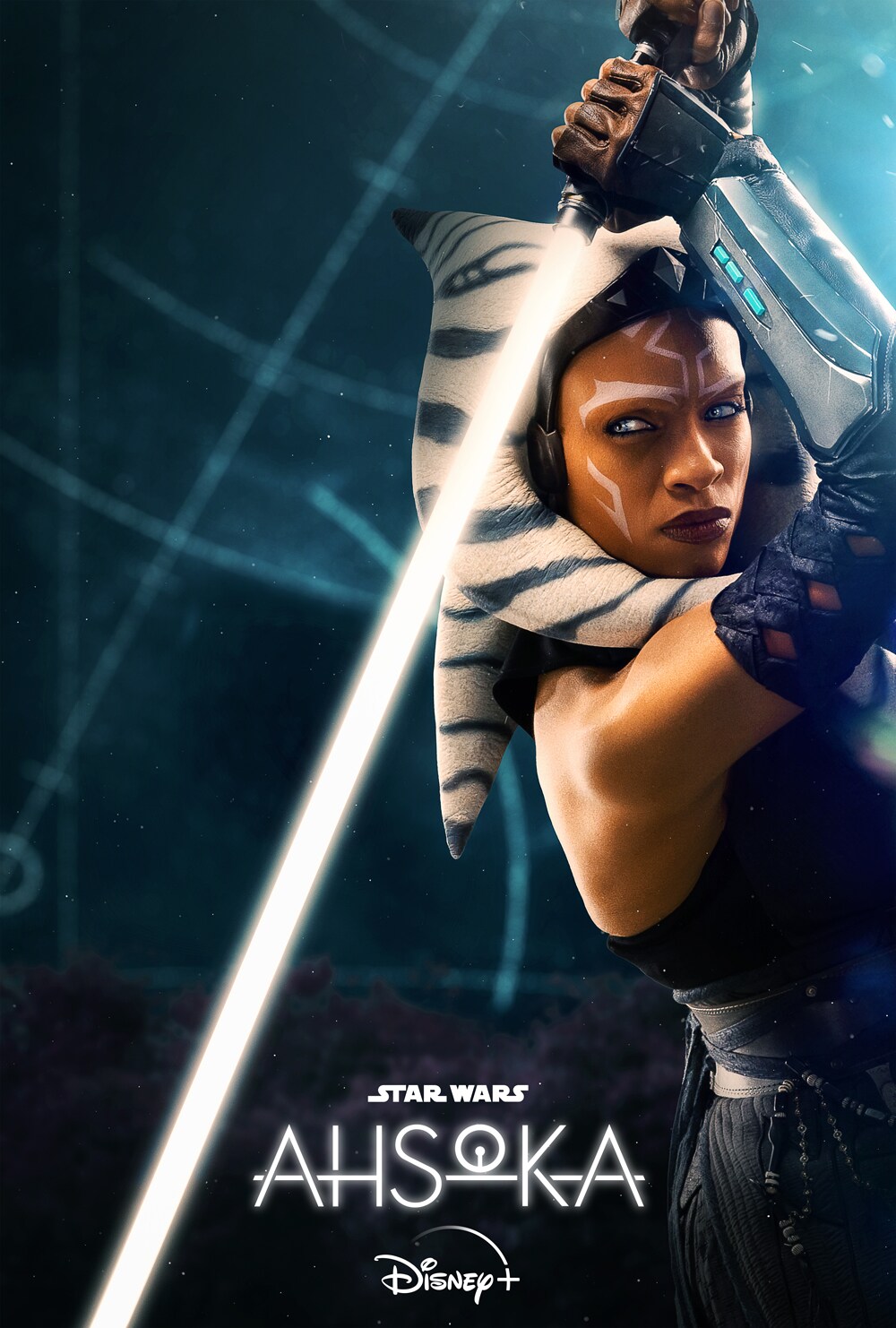
Producers: Lucasfilm, The Walt Disney Company
Aired: released weekly to Disney+
Episodes: eight
MPAA Rating: TV-14
EE Critic Score: 8/10
---
Ahsoka is an 8-episode streaming series produced for Disney+, starring Rosario Dawson as the titular Ahsoka Tano: war hero, self-exiled Jedi, and former apprentice to Anakin Skywalker. The show follows up on the finale of the animated series Star Wars: Rebels, telling the story of how Ahsoka Tano and Sabine Wren search for Ezra Bridger, a Jedi who went missing when he arranged for the flagship of an Imperial military leader who was attacking Bridger's home world to be pulled away into unknown space, with himself aboard. Sabine was Ezra's close friend for many years, and is eager to bring him back home now that the war with the Empire is over; Ahsoka fears that finding Ezra will also mean finding the Imperial officer, the strategic genius Grand Admiral Thrawn, who could take his place as Heir to the Empire if he returned to known space. Thrawn has allies still in the Galaxy and they, too, are moving to find his lost ship. The show is written and produced by Dave Filoni, producer of The Clone Wars, Rebels, and Resistance animated series, who also contributed to The Mandalorian and The Book of Boba Fett, and who has since been made Lucasfilm's Chief Creative Officer.
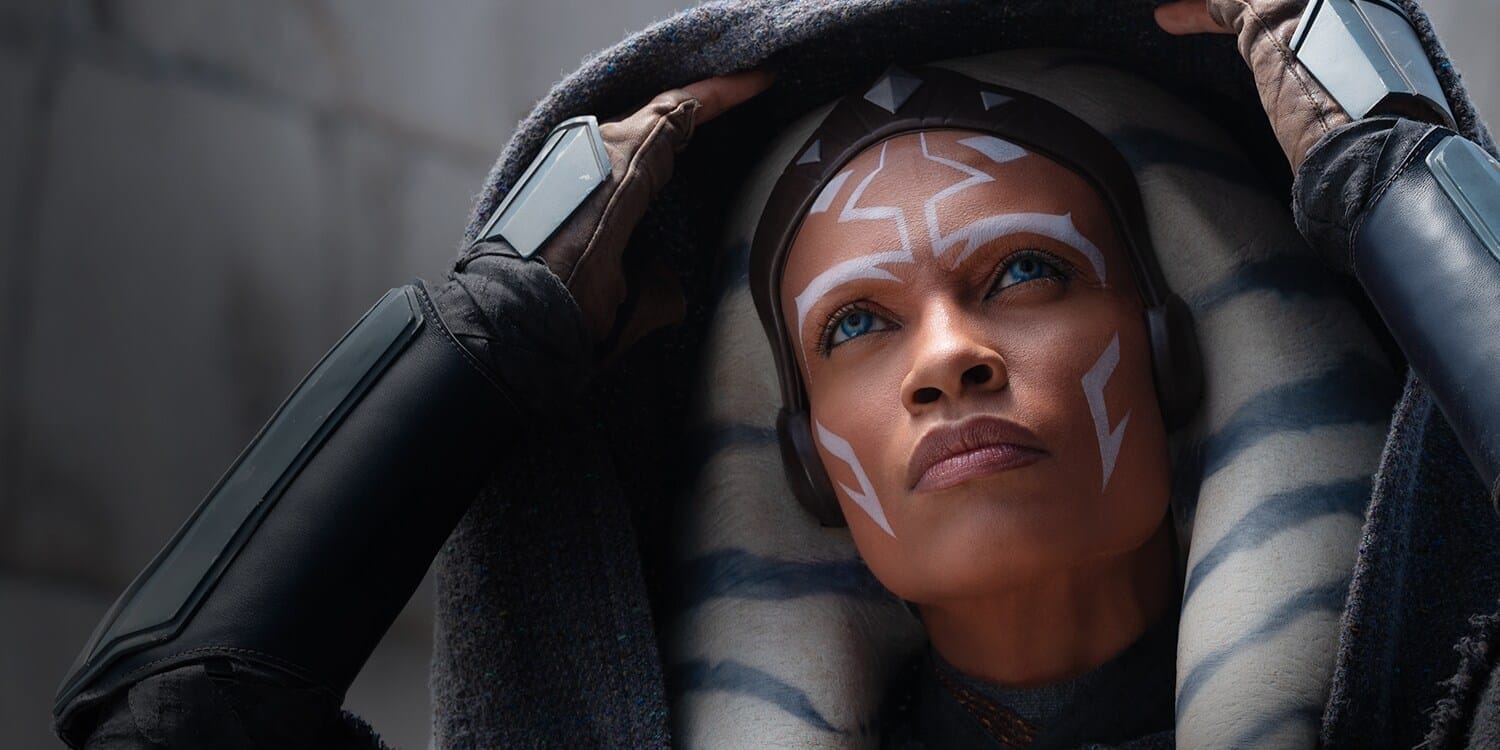
Synopsis
The series opens with Morgan Elsbeth (Diana Lee Inosanto), an old ally of Thrawn's, being freed from New Republic custody by mercenary and ex-Jedi Baylan Skoll (the late Ray Stevenson) and his apprentice, Shin Hati (Ivanna Sakhno). Elsbeth had been captured by Ahsoka Tano (Rosario Dawson), another former Jedi and Rebel operative who was seeking knowledge of what happened to Thrawn at the Battle of Lothal, at the beginning of the war against the Empire. Elsbeth told Tano of a map hidden in an ancient vault that would lead to where Thrawn's flagship had been taken by purgills, mammoth creatures able to travel through hyperspace on their own power. Tano retrieves the map but is unable to decipher its meaning.
Tano and her droid companion, Huyang (voiced by David Tennant) bring the map back to the New Republic fleet. There, Tano hears of Elsbeth's escape and meets with Hera Syndulla (Mary Elizabeth Winstead), a starfighter corps general who fought Thrawn at Lothal. Syndulla suggests that the map could be deciphered by Sabine Wren (Natalie Liu Bordizzo), a Mandalorian artist who had been part of Syndulla's core cell early in the war and to whom Tano had tried to teach the Jedi ways before the two had a falling out. While Wren likely won't help for Tano's sake, she might help to find Ezra Bridger. Tano brings the map to Lothal, where Wren takes it to her home, against Tano's wishes, and successfully deciphers it, However, Hati arrives in search of the map. Wren uses the lightsaber Bridger left her to try to fight Hati off, but the better-trained Hati out-duels her and leaves her wounded, taking the map.
Tano finds Wren and arranges for emergency medical attention but is upset that her rash actions lost the map. Tano and Syndulla attempt to find where Elsbeth might be by investigating some of her old holdings on Corellia. There, the starship factories are nominally under New Republic control, but the pair discover Imperial holdouts producing massive hyper-drive engines. Syndulla places a tracker on one of the engines while Tano is engaged in combat by Marrok (Paul Darnell), another of Baylan's mercenaries armed with the gear of an Imperial Inquisitor.
Tano, Huyang, and Wren depart in pursuit of the tracked engine; Syndulla requests permission to lead a New Republic squadron as backup but is denied. On the way, Wren insists on resuming her Jedi training; she spars with Huyang and Tano, and Tano guides her to open herself up to the Force in small ways to start. Wren tries to call a cup to her hand but cannot.
The Jedi discover Elsbeth building a huge hyperspace ring in orbit around a world once controlled by her people, the Nightsisters of Dathomir. It was the Nightsisters who made the map, and who built the cliffside stonehenge where it can be properly displayed; it shows the route taken by the purgills in their migration to another galaxy, where Thrawn and Bridger were taken. The Jedi are shot down by merc starfighters, and they set off through the forest to reach the henge. Tano tells Wrent that destroying the map may be the only way to prevent Thrawn from returning. As they make their way, Marrok and Hati intercept them. Tano bests Marrok, who bursts into green smoke as he's felled, before continuing on toward the clifftop. Wren fights Hati, coming close to losing again before surprising Hati with a blaster shot. Convinced Tano is the only true threat, Hati flees after her, and Wren runs after Hati.
Tano attacks Skoll at the clifftop; he is a stronger fighter than Hati or Marrok, and, when Tano is distracted by Hati and Wren's arrival, he casts her down into the sea. Skoll then turns toward Wren, offering to spare her if she will allow Elsbeth to finish copying the map to her ring ship's navicomputer. Wren, positioned to destroy the map but unable to give up hope of finding Bridger, agrees. Skoll takes her prisoner, and, once the map is copied, destroys it himself to prevent anyone from following them. The ring ship jumps to hyperspace just as Syndulla arrives leading an unsanctioned squad of X-wings. Landing on the planet, Syndulla finds Huyang alone. They search for Tano and Wren without success. Syndulla's son, Jacen (Evan Whitten), says he can hear a lightsaber battle under the ocean waves.
Near death, Tano finds herself in what appears to be the World Between Worlds. There, she is confronted by the spirit of Anakin Skywalker (Hayden Christensen), her old Jedi Master. He says he is there to complete her training. He and she travel through dream-like visions of the Clone Wars, before dueling. Skywalker tells Tano she faces one choice: live or die. Tano chooses to live. As she returns to consciousness, she is recovered by one of the X-wing pilots. Tano senses through the Force that Wren was taken by Skoll aboard the ring ship. She and Huyang depart, stowing their ship away in the mouth of a migrating purgill to pursue Elsbeth, and Wren, to the other galaxy.

Elsbeth's group drops out of hyperspace near Peridea, the original homeworld of the Nightsisters. There, they find a fortress and a trio of Nightsister Great Mothers (Jeryl Prescott, Claudia Black, and Jane Edwina Seymour), very powerful Force-witches who had been telepathically conveying Thrawn's commands to Elsbeth. Soon after the Chimaera arrives over the fortress, bringing Thrawn (Lars Mikkelsen). Thrawn sends Wren out into the wilderness, saying she will find Bridger there. After she leaves, he sends Skoll and Hati after her, with orders to kill her and Bridger. Thrawn then confers with Elsbeth; he refuses to take Skoll's word that Tano is dead and begins preparing for her arrival. Then he has his men start moving crates from the temple onboard the Chimaera.
Wren encounters bandits, whom she fights off, and later a group of hermit-crab-like people, the Noti, who live under the protection of Ezra Bridger (Eman Esfandi). Upon re-uniting with him, wren tells Bridger of what happened in the Galaxy since he left.
Tano and Huyang arrive with the purgills amidst a minefield layed by Thrawn. They dodge the mines and intercepting starfighters to reach the planet, where Tano senses Wren's presence.
Skoll and Hati ally with the bandits. Then they find Wren and Bridger, Skoll tells Hati to attack them and take her place in Thrawn's new Empire, but that his path leads elsewhere; he then departs. Wren and Bridger work together to defend the Noti from hte bandits. Bridger refuses to take back the lightsaber he left for Wren, instead fighting with the Force. Ahsoka arrives and forces Hati to yield, driving her and the bandits off.
Aboard the Jedi shuttle, Bridger constructs a new lightsaber, Huyang guiding him as he once guided Bridger's master and generations of Jedi before him. The shuttle is soon after shot down by TIE fighters; Thrawn seeks to force the Jedi to assault the fortress on-foot. The Great Mothers prepare a defense, empowering Elsbeth in a ritual and arming her with the Sword of Talzin. A group of volunteers from Thrawn's stormtrooper ranks are made into "night-troopers", who will reanimate again and again when killed. Elsbeth and the night-troopers are deployed into the fortress to buy Thrawn time to finish loading the Chimaera and escape. The Jedi fight their way through; Wren, in the heat of the battle, finally finds herself able to wield the Force. Bridger manages to stow aboard the Chimaera, while Wren stays back to aid Tano against Elsbeth. Huyang arrives with the repaird shuttle in time to pursue the Chimaera, now linked with the ring ship, into space. Thrawn salutes Tano as a worthy opponent, then jumps to hyperspace.
Thrawn arrives at Dathomir. Bridger steals Skoll and Hati's old shuttle to escape to the New Republic fleet, where he re-unites with Syndulla. Skoll discovers massive statues of the Mortis gods carved into the mountains on Peridea. Hati returns to the bandits, while Tano and Wren return to the Noti. In their camp, Tano senses Anakin Skywalker's spirit watching over them. Wren seems to as well.
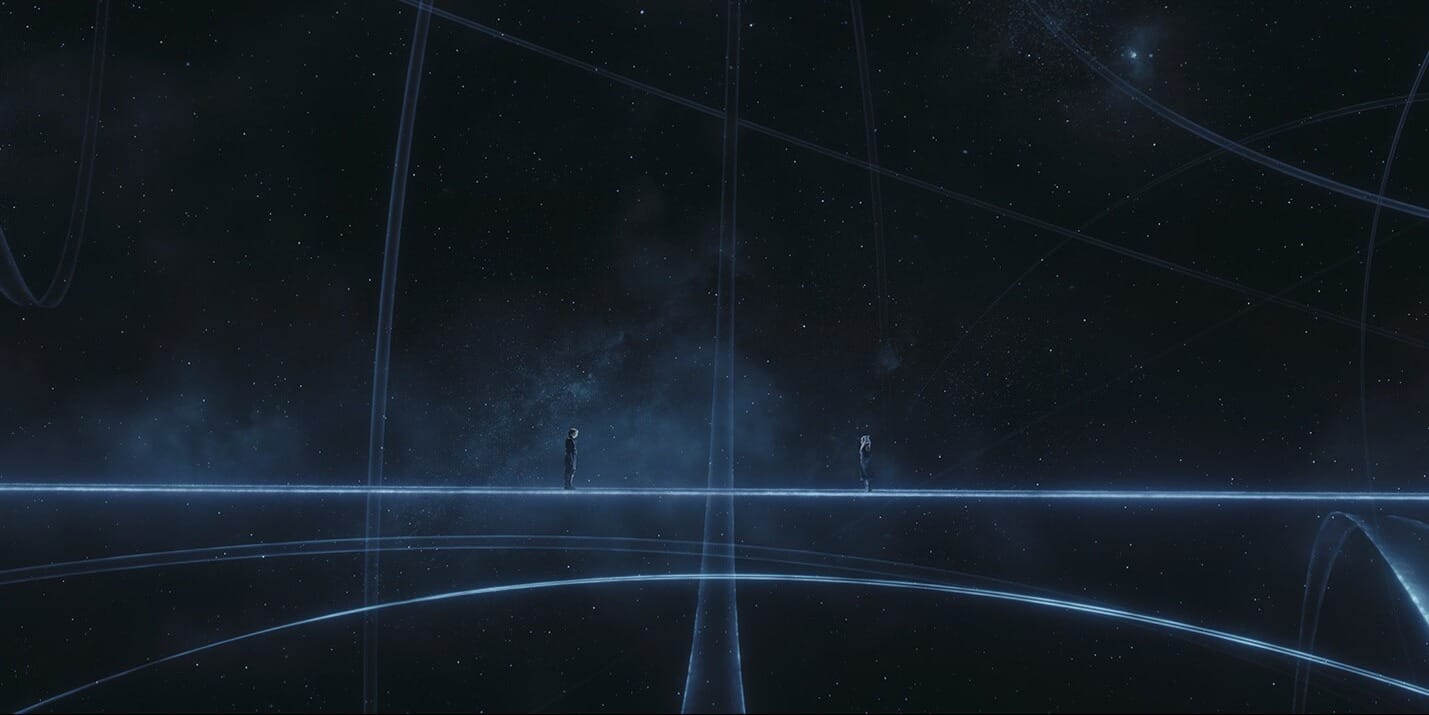
Analysis
It's hard for me to review this show, to be quite honest. I'm a Star Wars fan, sure, but specifically I'm a Clone Wars fan; that's the Sar Wars that was new when I was a kid, so that's the Star Wars that really got me into Star Wars. (Truth be told, the Star Wars that first got me into Star Wars was Attack of the Clones, and Jude Watson's Jedi Apprentice books, but Clone Wars cemented things.) I've been watching the adventures of Ahsoka Tano in some form or another for fifteen years, on-and-off. I came to Rebels a bit later than some, but when I did, I liked that, too. This show is, in most ways, those shows, but with the...charming, but sometimes odd-looking animation replaced with gorgeously realized live action. Thus, much of my experience watching Ahsoka was just a constant stream of "this is awesome this is awesome this is awesome" running in my head.
Trying to take a step back and look at it, this show seems to be Filoni's attempt to grow up, as it were. Most of the hallmarks of his sort of Star Wars are all here: 1vmob starship battles, Jedi training, things named after wolves, Captain Rex. But Ahsoka does a lot less to explicitly appeal to kids than Filoni's earlier work. It's not like Andor, which had almost nothing that would appeal to children; it's still a sci-fi fantasy action show with all sorts of crazy, outlandish things that would appeal to audiences of all ages. But there's nothing aimed right at kids. Case in point; it's not about kids. Ahsoka, Ezra, and Sabine were all kids in earlier shows, older than their audience, but not adults, as they are here. The only kid in the show is Jacen Syndulla, who's only in a couple episodes as an extended cameo. Ahsoka does not have the coming-of-age story that Filoni's other shows had. Indeed, it comes off a bit critical of the resultant prevalence of child soldiers in Filoni's work. Rosario Dawson's Ahsoka isn't as chipper as Ashley Eckstein's; that's a legitimate complaint one could have with the show, but it's also in keeping with Ahsoka's story to this point. She's not a kid anymore; she's a middle-aged woman who's been through a lot. The flashback showing a teenage Ahsoka growing up in a series of warzones isn't played as cool and adventurous here, as it often was in The Clone Wars, because this show isn't made for kids as much.
In the absence of much humor, though, a lot of moments came off a little awkward. There's a lot of in-fighting amongst the show's heroes that gets a bit tiring to watch as it keeps going. The series is also uncharacteristically non-hopeful in its themes. The end of Rebels had Sabine talking about how the war was hard, but they won in the end and were all heroes to the Galaxy, and then she and Ahsoka go off to find Ezra, but then this show makes finding Ezra an afterthought for everyone but Sabine. Ahsoka and even Hera are mainly concerned that Thrawn might return and mobilize a fifth column against the New Republic, concerns which seem to be well-founded. This all works, plot-wise, and even as entertainment, but the show does feel more grim, without feeling any more grounded, than we're used to.
Besides the less juvenile tone, Ahsoka is differentiated from earlier Filoni work by being live action. This is more than just an aesthetic change; live-action Star Wars is expensive toHeo, much more expensive than the animation done for Clone Wars and Rebels. Having live-action non-human characters costs more than having human characters, whereas in animation all humanoid characters should cost about the same to bring to life. Live-action starship scenes mean making physical models and elaborate filming rigs. The way to save money is just to make less of a live-action project, which is why this show is an eight-episode season, while animated shows have between two and three times as many episodes per season. and besides that, this season is written with a single story all the way through. Filoni's animated shows tended to have a few stories per season, some multi-episode arcs, some one-off episodes. At eight episodes each between forty minutes and an hour long, the season could have featured a couple of distinct arcs, but instead, events flowed together quite seamlessly. It didn't follow the short-arc pattern of The Clone Wars, or the episodic pattern of The Mandalorian; instead, it follows the extended, chopped-up movie pattern of Obi-Wan Kenobi (and most other streaming series). The result is a show in some ways shorter than earlier Filoni projects, but in other ways longer.
Ahsoka might be said to be about two things: from the perspective asking where this fits into and what this adds to the Star Wars timeline, this is about how Thrawn returns to the Galaxy, the start of what I expect to be the ongoing story in Star Wars television for the next few years. But otherwise, this show is largely about what it means to be a Jedi post-Jedi-Order. Most of the major characters are addressing that question in some way: Ahsoka is uncertain how to continue Jedi tradition that she herself has mixed feelings about; why be a Jedi? Sabine is determined to be a Jedi, despite not being up to the standards of the Jedi of old; who can be a Jedi? Baylan Skoll and Shin Hati carry on Jedi traditions in their own way, with Baylan seeming to hold to what in Legends would have been pre-Ruusan-reform ideals of Jedi serving the Galactic peace as warlords rather than as diplomats; what are truly the Jedi ways? Huyang embodies all-but-lost Jedi heritage, serving as a link to the past, not just to the Order's final days, that Ahsoka and Baylan both knew, but to its deeper history; what was the Jedi Order? Ezra's role among the Noti, as a protector against bandits, seems closest to the Jedi ideal, but he leaves in the end to help save the galaxy from Thrawn, because that's where he feels most needed, and most at home; what is a Jedi's calling?
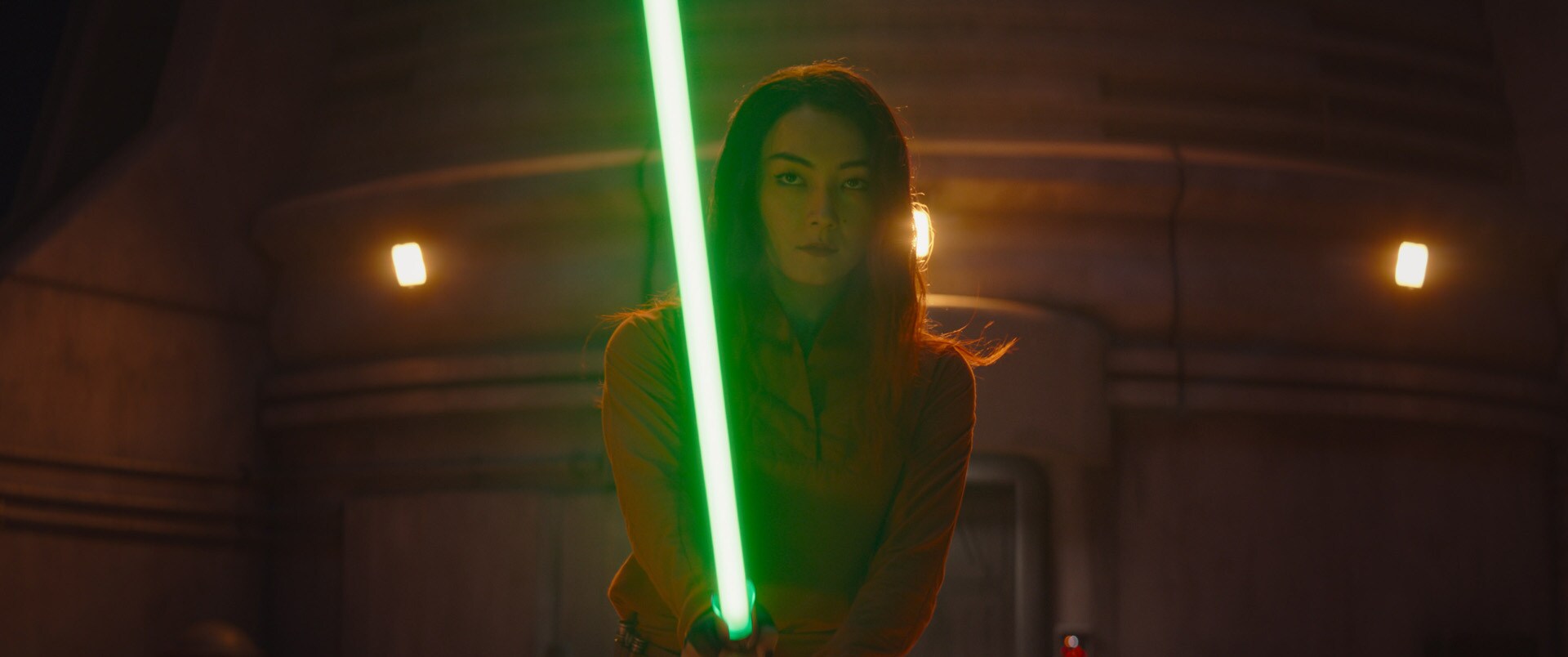
Sabine training as a Jedi was the most controversial part of the show. When I first saw Sabine call Ahsoka "master" in one of the trailers, I thought it was a misdirect. Sabine knew Kanan before Ezra did; if she showed aptitude toward being a Jedi, he would have tried to train her. As I watched the show's premier, two things became clear: the "master" line wasn't a misdirect, and the show remembered that Sabine wasn't strong in the Force. Instead, this plotline was finally delivering on a concept thrown out a while ago by George Lucas: that anyone could use the Force, it's just easier for some than for others, and the Jedi are just the ones who bother to learn how. That's why, when The Phantom Menace showed Qui-Gon figuring out that Anakin was Force-sensitive via a blood test, people were so upset; that seemed to conflict with the notion that anyone could be a Jedi if they tried hard enough. Ahsoka walks a line down the middle on this: Sabine might not be up to the standards of the old Order, which could afford to only recruit the most promising candidates (not to mention only infants), but in a post-Order galaxy, there's no longer such a system in place, nor are there already plenty of Jedi around. Having a Jedi of this era try to train an eager friend with marginal talent is a good concept for a story and Sabine, who knew Jedi and who even had some lightsaber skills, is a good pick to fill that role.
So, I'm not opposed to Jedi Sabine Wren in principle, but I'm a little disappointed in her in practice. Not a whole lot was done to show her being a Jedi beyond her fighting with a lightsaber and doing a bit of telekinesis at the end. She was essentially a Jedi-class character in a video game. Like, if you play as a Jedi in Battlefront or Lego Star Wars you have a lightsaber and telekinetic powers; that's what makes you a Jedi in that context. But it's a pretty shallow view of what a Jedi is otherwise. The Jedi don't just use the Force for performing tricks, they use it to deepen their understanding of the world.
The first great feat we ever saw a Jedi perform was Luke Skywalker firing a proton torpedo to blow up the Death Star. He didn't use telekinesis to guide it when the spirit of Ben Kenobi told him to "use the Force"; he switched off his targeting computer, closed his eyes, and sought the Force's guidance in when to fire. Sabine doesn't really have a similar trust-in-the-Force moment. Being a Jedi is not just about being a great warrior. That was Anakin's final lesson to Ahsoka: that she could live as a Jedi, not just fight and die as one. But then the further events in hte show only call for warriors, so that lesson gets blunted quite a bit. I could see Ahsoka and Sabine taking up more rounded Jedi roles among the Noti, but that would be a future story.
So, too, would be Baylan's quest into the mountains of Peridea to seek some deeper understanding of the Force from whatever cut statues of the Mortis gods there. Generally, this speaks to how the season ends before it feels like anything has been resolved. The finale ends on about five cliffhangers: Baylan in the mountains, Ezra's return, Ahsoka and Sabine stuck on Peridea, Shin taking charge of the bandits, and Thrawn's arrival at Dathomir.
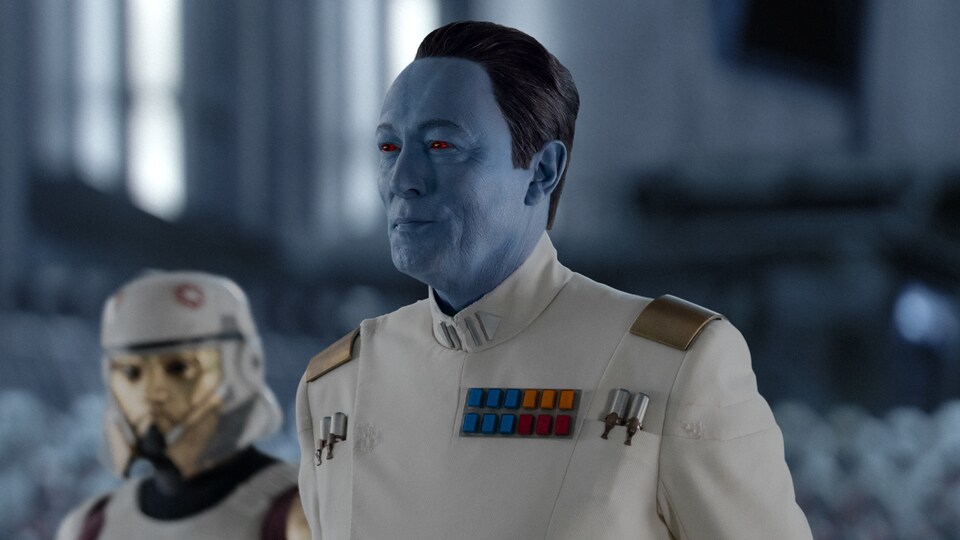
Speaking of Thrawn. I've written about everything he's appeared in up to this point, so I'd better pay him some special attention here. He's portrayed well in this show, but he really doesn't get to shine much. Unlike the other Rebels/Clone Wars characters in the show, Thrawn is portrayed by his original voice actor; Lars Mikkelsen's performance here is unsurprisingly identical to his performance in Rebels. The general bullet-points of Thrawn's character are all demonstrated pretty clearly. He's shown to be resolutely mission focused; he needs to load his ship and leave, and he doesn't let the arrival of Ahsoka distract him from that. He lacks the arrogance otherwise typical of Imperial officers, as we see when he refuses to accept reports of Ahsoka's death without being shown a body. He is beloved, not feared, by his troops. And he's distrustful of Force users. That last element is something with roots all the way back in Zahn's original Thrawn trilogy, but which became much more explicit in more recent books.
For a deeper look at Thrawn's history as a character in Star Wars, check out my "Thirty Years of Thrawn" retrospective:
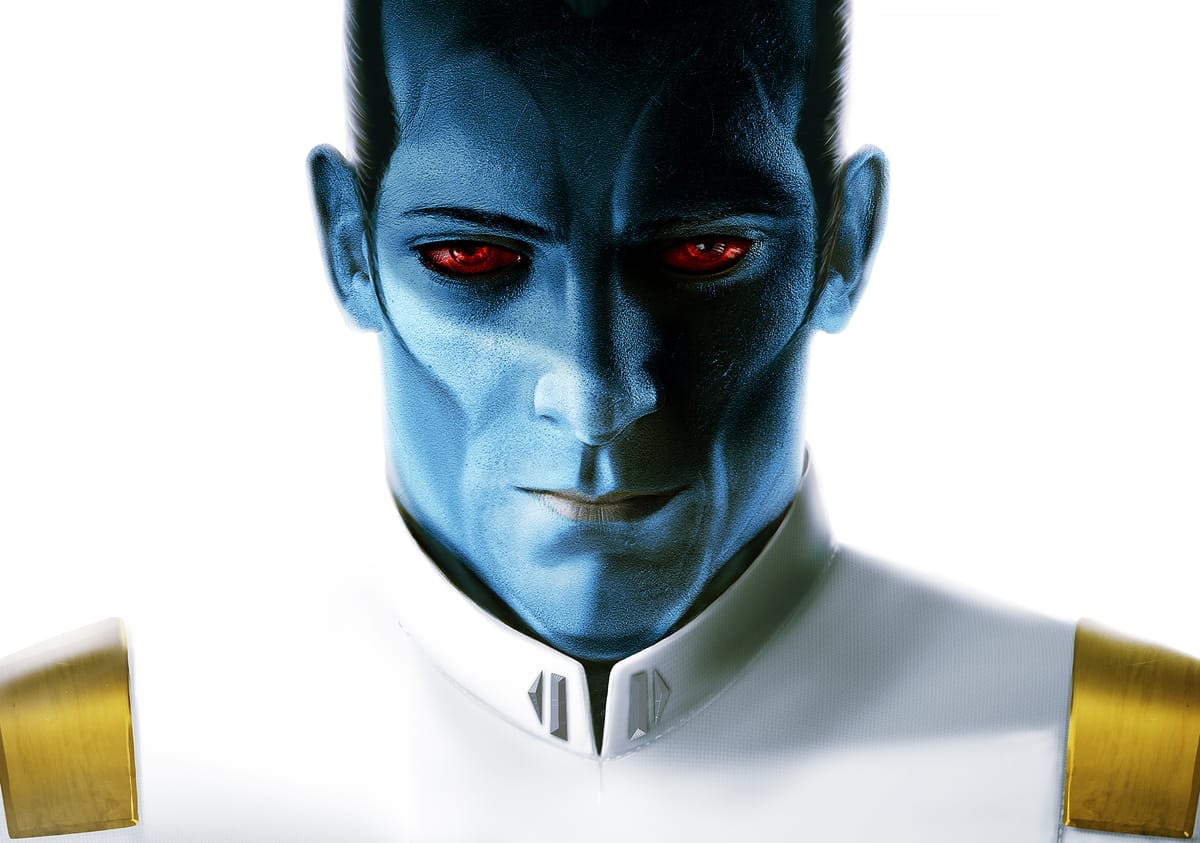
Thrawn joined the Imperial cause to ensure galactic stability in hte face of outside threats, but he held Palpatine in contempt (privately). He respected the power of Force users, but he never put much faith in their decisions. Here, we see Thrawn allied with the Nightsisters quite closely, but he's the one in charge, which he makes clear when he casually destroys their castle on his way off Peridea. Also, Thrawn immediately dispenses with Baylan and Shin, sending them off chasing Sabine and then not waiting for them to get back before launching the Chimaera. He may not be carrying an ysalamir around on his back, but he's still trying to keep the Force at arm's length from him.
That said, Thrawn doesn't do a whole lot here besides show up. His entrance is spectacular, but from there on out, there's nothing to do but pack his things and go, while running out the Jedi's clock. He does that deftly, but he has no grand military victory. He faces no real military challenge. His plans upon returning to the Galaxy are unknown at this point; there's opportunity for him to play really well as a villain for the New Republic fleet, but, like so much else, that's going to have to be a future story.
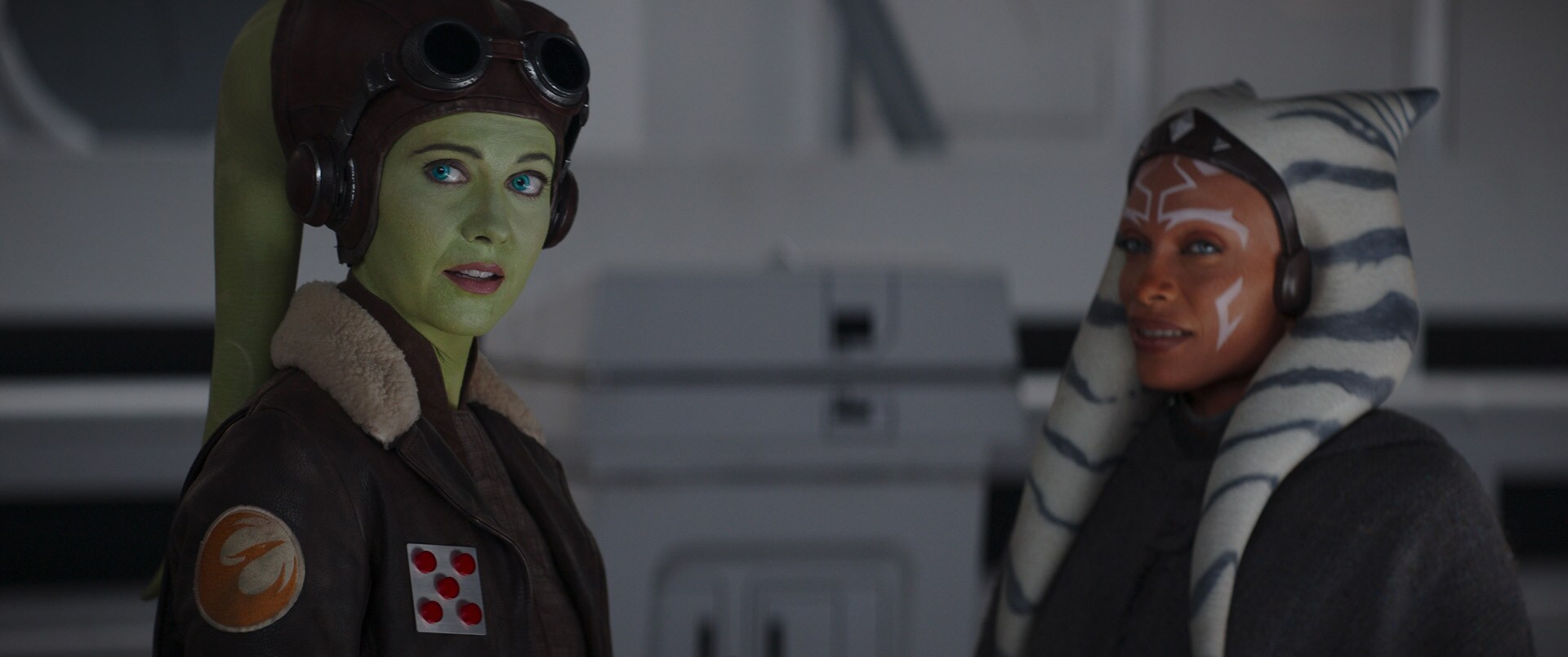
Production-wise, this show was pretty much flawless. The sets are all well-designed; the obvious, cramping overuse of the Volume and other soundstages that plagued Obi-Wan Kenobi especially isn't an issue here. The cliffside henge where the map is read was probably the best location featured. The action is generally well-shot. Duels, especially, are well done. There are more swordfighters in this show than anything Star Wars has put out for years, and all of them were given a distinct and entertaining style. The mob fight scenes, however, weren't as good. Honestly, scenes where two or three heroes fight a few dozen enemies are hardly ever good, but they're often kept short and snappy. The last couple episodes of Ahsoka featured extended mob fights as main set pieces, and while they could have been worse, they weren't as engaging as the rest of the show.
In a first for a live-action Star Wars project (since the Holiday Special, anyway) Ahsoka features non-Humans in lead roles, which presents a make-up effects challenge that was met well. Blue Lars Mikkelsen looked just like Thrawn, moreso even than the character model in Rebels, which always looked a little too turquoise to me. Rosario Dawson's Ahsoka we'd already seen, of course. I remember there being complaints when she first appeared in The Mandalorian that her montrals and head-tails weren't large enough for a Togruta her age, which is, first of all, a hard-core nerd complaint even for Star Wars, and also is sort of a complaint I get. But really, I'd blame whoever first designed Shaak Ti and gave Togrutas really unworkable giant stuff on their heads in the first place. All that said, the prosthetics and makeup for Dawson's Ahsoka looked good, quite natural, and not like a costume piece. The only trip up the show made in costuming was Hera's lekku, which really did look like a costume piece, and which bounced around distractingly in most of her scenes.
Kevin Kiner, who wrote the music for The Clone Wars and Rebels, returns to do the score here. Given his history his music, to my ear, is just as evocative of Star Wars as John Williams's. After each episode I watched through the full credits sequence to hear the show's main theme, the same as I did for The Mandalorian. The organ music that plays when Thrawn first arrives is a callback to his theme from Rebels, which sadly never gets fully played in this series.
As much as I complained that things in this show didn't develop fully, I did really love watching this series. But as much as I loved this series, I'm a fan. While I don't think one has to be a fan to understand and enjoy the show, I do wonder if Ahsoka will produce a bunch of new Ahsoka fans. Someone without a background watching Clone Wars and Rebels will find this show accessible, but maybe not so meaningful. And I'm not sure there's enough to this show, just on its own, to interest a new fan. Perhaps watching this show prompts them to go back and watch Clone Wars and Rebels, and they become Ahsoka fans in that way.
Then again, I don't think this will be the only season of Ahsoka, and even if it is, the threads started in this show will be picked up in future projects. Dave Filoni has, historically, taken a season or so to get things set up before a show really becomes great. I get the feeling that's what's happening here.
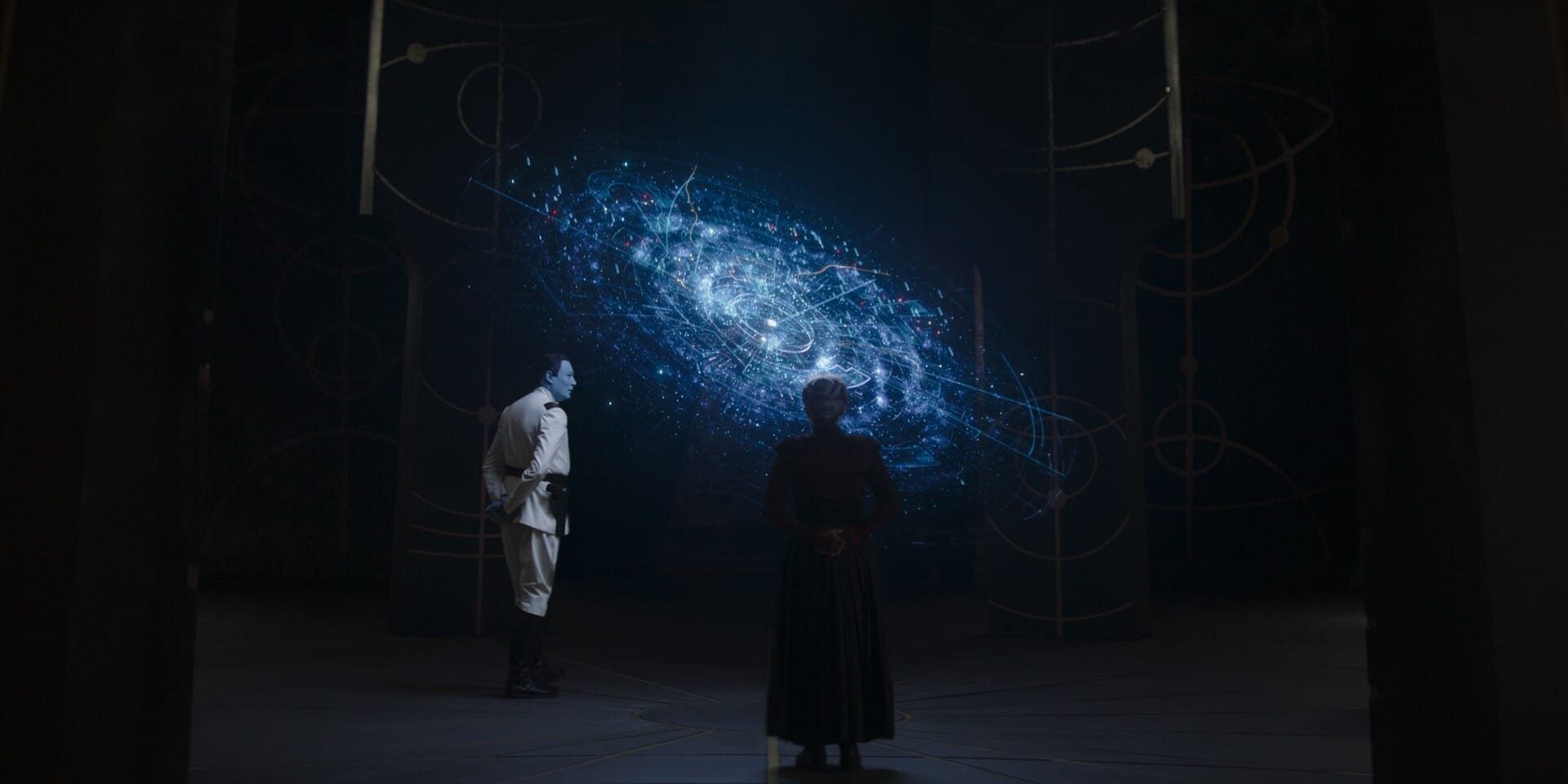
Recommendation & Rating
Fans of The Clone Wars and especially of Rebels will get a lot from this series in terms of seeing how Ahsoka's story continues and in seeing things from those shows realized in live action. Fans of Thrawn will likely also love his depiction here, though he isn't featured for most of the show, and even afterward he's given less to do than he had in earlier works. Star Wars fans without as much familiarity with those things should still be able to enjoy the show, which does an effective job of re-introducing characters and which was, more broadly, clearly made with such fans in mind, so a degree; a few character moments and reunions might not be as impactful, is all. Non-Star Wars fans might enjoy the numerous well-choreographed sword fights but probably wouldn't get much from this series on its own.
Overall, the season was well done, but felt truncated, ending just as things felt like they were really getting going. Leaving viewers wanting more is great, but leaving them feeling like they were given a complete story is also important. What's there, though, is great and clearly done with a lot of care for details. I give Ahsoka, Season 1 a soft
8
/10 — Without significant negative worth. Able to be recommended to the interested without reservation.





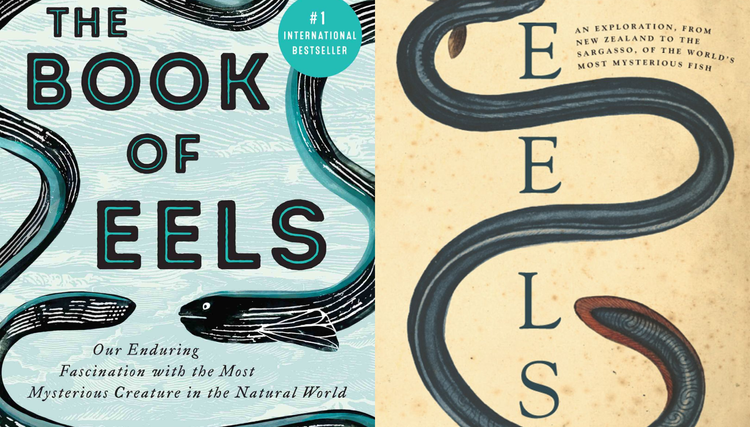

Member Commentary